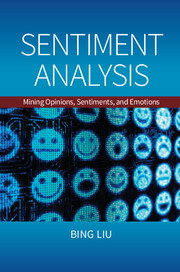Book contents
- Frontmatter
- Contents
- Preface
- Acknowledgments
- 1 Introduction
- 2 The Problem of Sentiment Analysis
- 3 Document Sentiment Classification
- 4 Sentence Subjectivity and Sentiment Classification
- 5 Aspect Sentiment Classification
- 6 Aspect and Entity Extraction
- 7 Sentiment Lexicon Generation
- 8 Analysis of Comparative Opinions
- 9 Opinion Summarization and Search
- 10 Analysis of Debates and Comments
- 11 Mining Intentions
- 12 Detecting Fake or Deceptive Opinions
- 13 Quality of Reviews
- 14 Conclusions
- Appendix
- Bibliography
- Index
9 - Opinion Summarization and Search
Published online by Cambridge University Press: 05 June 2015
- Frontmatter
- Contents
- Preface
- Acknowledgments
- 1 Introduction
- 2 The Problem of Sentiment Analysis
- 3 Document Sentiment Classification
- 4 Sentence Subjectivity and Sentiment Classification
- 5 Aspect Sentiment Classification
- 6 Aspect and Entity Extraction
- 7 Sentiment Lexicon Generation
- 8 Analysis of Comparative Opinions
- 9 Opinion Summarization and Search
- 10 Analysis of Debates and Comments
- 11 Mining Intentions
- 12 Detecting Fake or Deceptive Opinions
- 13 Quality of Reviews
- 14 Conclusions
- Appendix
- Bibliography
- Index
Summary
As discussed in Chapter 2, in most sentiment analysis applications, one needs to study opinions from many people because due to the subjective nature of opinions, looking at only the opinion from a single person is usually not sufficient. To understand a large number of opinions, some form of summary is necessary. Definition 2.14 in Section 2.2 defined a structured opinion summary called aspect-based summary, also known as feature-based summary in Hu and Liu (2004) and Liu et al. (2005). Much of the opinion summarization research is based on this definition. This form of summary is also widely used in industry. For example, both Microsoft Bing and Google Product Search use this form of summary in their opinion analysis systems.
In general, opinion summarization can be seen as a kind of multidocument text summarization. Traditional text summarization has been studied extensively in NLP (Das, 2007). However, an opinion summary is quite different from a conventional single document or multidocument summary (of factual information). The reason is that an opinion summary should (1) be centered on entities and aspects and sentiments about them and (2) be quantitative. Traditional single document summarization produces a short document from a long document by extracting some “important” sentences, while traditional multidocument summarization finds differences among documents and discards repeated information. Neither of them explicitly captures different topics/entities and their aspects discussed in the documents, nor do they have a quantitative perspective. The “importance” of a sentence in traditional text summarization is typically defined operationally based on the summarization algorithms and measures used in each system. Opinion summary, on the other hand, can be defined formally in a structured form and represented as structured objects (see Definition 2.14). Even for output opinion summaries that are short text documents, there should still be explicit structures in them.
After discussing summarization, we move the topic of opinion search or retrieval in this chapter.
Information
- Type
- Chapter
- Information
- Sentiment AnalysisMining Opinions, Sentiments, and Emotions, pp. 218 - 230Publisher: Cambridge University PressPrint publication year: 2015
Accessibility standard: Unknown
- 1
- Cited by
